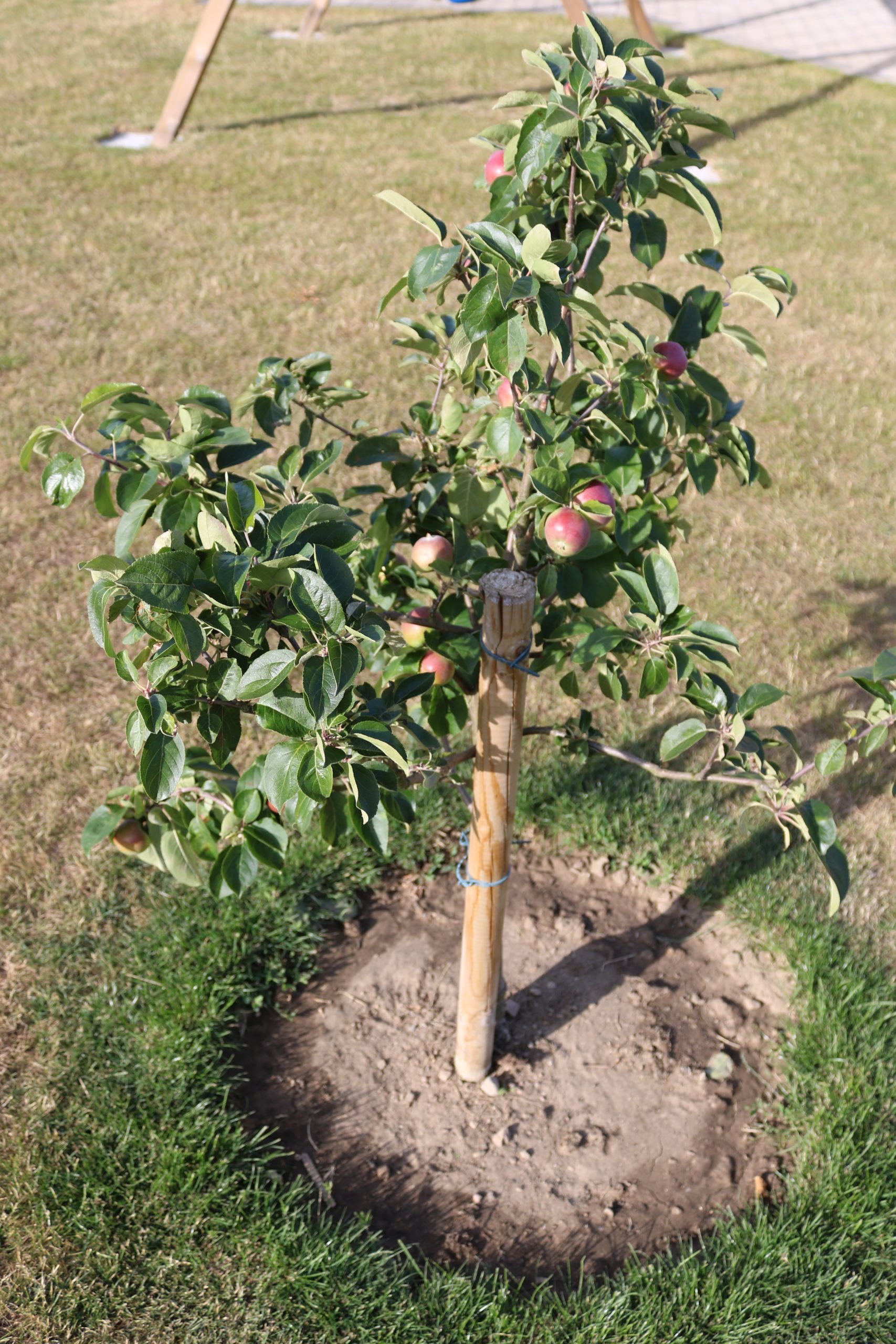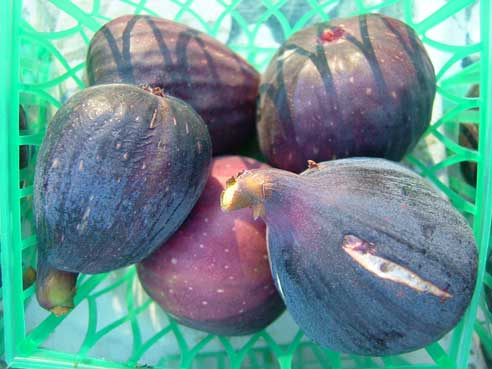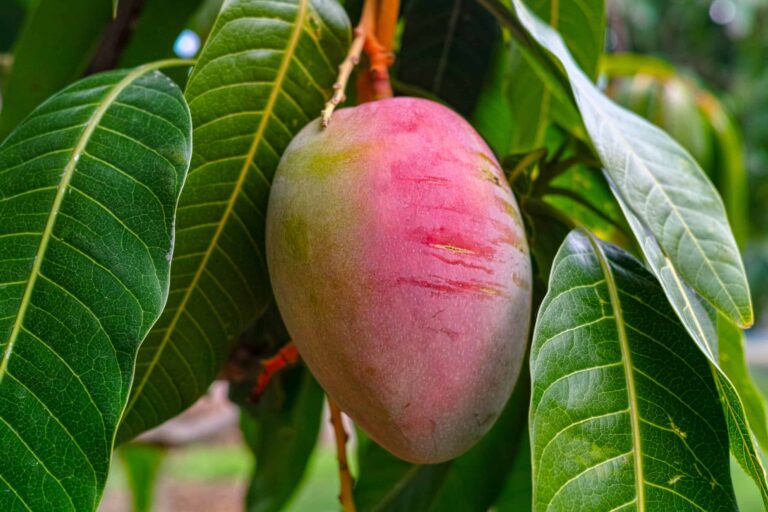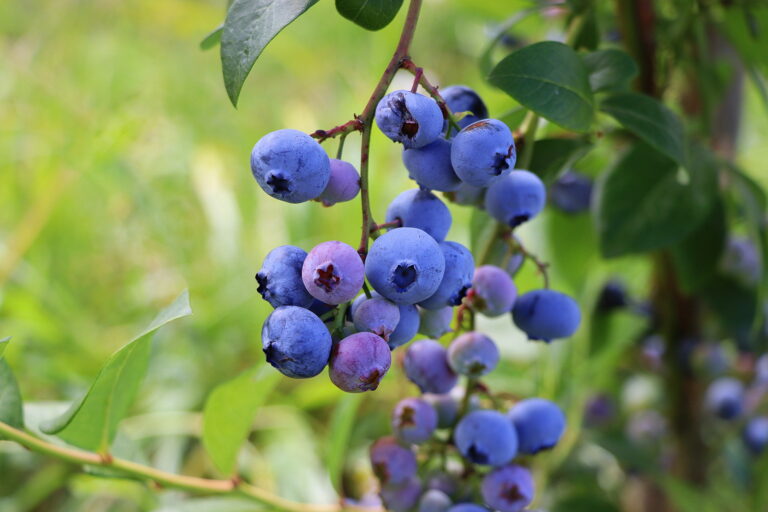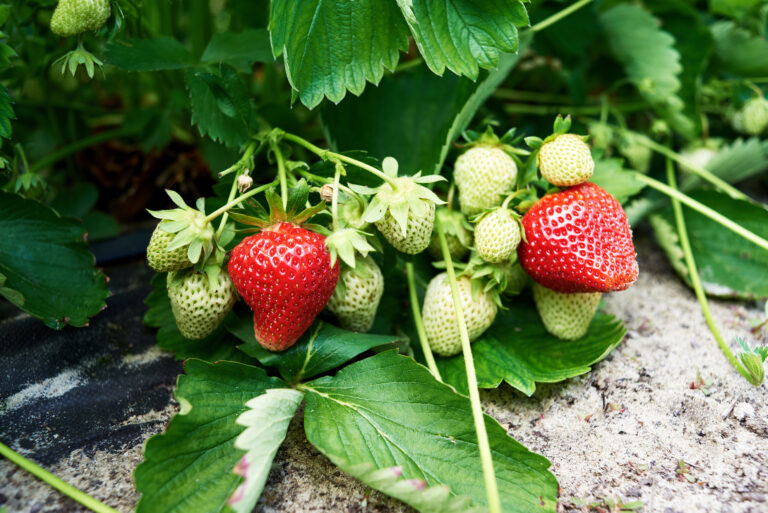How to Train and Prune a Fruit Tree
Young fruit trees require early training. It is best to begin training a fruit tree as soon as it is planted. Young tree training is best continued for the first three or four years of the tree’s life.
Training a fruit tree includes staking, pruning, and branch spreading. All of these will help create a strong framework of limbs. A strong framework of limbs is essential for years of growth and productive harvests.
Fruit trees that can benefit from early training include apples, pears, peaches, cherries, and plums.
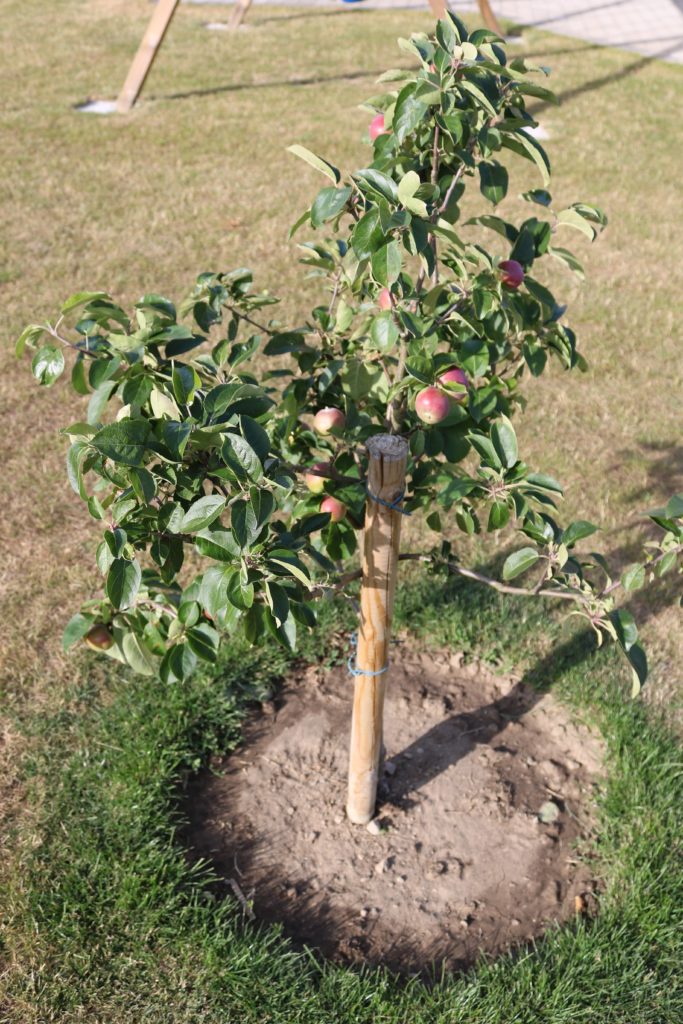
Planting time training
At planting time, cut the main leader or central stem of your young tree back to about 24 to 30 inches (60 cm–75 cm) above the ground. This cut will encourage the growth of important side branches.
Many young trees are branchless whips. Do not be concerned. They will develop side branches in short order.
If your young tree has lateral branches, make the top cut immediately above a strong lateral branch. Next, select two additional lateral branches to begin training in the tree’s framework. Choose one, eight inches below the top lateral, and a second another eight inches lower. These branches are best if they are arranged as spokes to create an imaginary circle around the stem as you look down from above the center of the tree. Cut away other less substantial laterals. Once you have chosen these important lateral branches cut them back by about one-third to outward-facing buds.
These laterals will become the framework of your tree in maturity. It is important that these framework limbs be evenly spaced. Once cut back, allow two buds to develop on each of the laterals, one at the end and one halfway between the branch end and the stem. These buds will, in turn, develop sub-lateral branches to become part of the tree’s overall framework. Be sure to rub off any new shoots that later sprout on the tree’s main stem. They are not needed and rob energy from the tree if allowed to grow.
Training first summer after planting
If your tree had no lateral branching at planting time, allow laterals to develop during the tree’s first summer of growth after planting. At the end of the first summer, choose three or four well-spaced branches that you plan to develop into the permanent framework as described above. Cut these branches back by about half. Prune away any unwanted branches or side shoots.
There are simple pruning cuts that you must perform from the tree’s first summer forward. These cuts are essential for a healthy and productive tree.
- Remove any dead, damaged, or diseased wood from the tree.
- Prune away the weaker of two branches growing from the same spot.
- If two branches are growing in opposite directions, keep the branch that is best placed.
- If two branches cross or rub against one another, remove the weaker of the two.
- If two branches are growing parallel to each other, one over the other, keep the one that is best placed and remove the other.
Central leader and open-center training
At the end of the first summer of training, decide if you want to train your tree for a central leader, a modified central leader, or an open center.
Central leader training produces an upright tree, symmetrical in shape, with a continuous central trunk. A modified central leader–sometimes called a multi-leader–is much like a central leader, but the central shoot is eventually removed and the laterals encouraged. Apples, European pears, sweet cherries, and European plums are commonly trained to a central or modified central leader.
Open-center training produces a tree without a central leader or trunk, a tree shaped like a vase. With the central leader removed, open-center training limits the height of a tree and allows for easy pruning, care, and harvest. Apricots, Asian pears, peaches, nectarines, sour cherries, and Japanese plums are commonly trained to open centers.
Central leader training
After the first summer of growth, thin out new laterals or shoots growing at a narrow-angle to the central leader or stem.
- Established lateral framework branches are cut back by one-third to one-half.
- A modified central leader can be created after the first summer by cutting back the central leader. This will encourage side branching below the now-removed central leader.
- Following the second summer of growth, three or four additional side branches can be added to the tree’s framework. Again, choose branches that are evenly spaced around the trunk for development.
- Always remove water sprouts–green vertical whips–that grow up from the trunk or side branches. Also, remove suckers that grow from the base of the trunk or roots.
- Trim framework laterals back by one-third to one-half of the previous season’s growth. And cut away any new narrow-angle branches growing from the trunk. Leave 4 to 6 buds on lateral branches to encourage growth next year.
- In the next two or three summers, continue to select new tiers of branches to add to the tree’s framework.
- As the tree begins to fruit during the third or fourth summer after planting, trim out downward pointing branches.
- Trim upward-growing shoots back to ¼ inch (6 mm) stubs. These will become fruiting spurs.
Open center training
An open-center tree can be created the first summer following planting by cutting the central leader or shoots off just above the uppermost lateral framework branch.
- Encourage new sub-lateral branching by cutting back framework branches by one-third.
- The second spring after planting, cut back the previous year’s shoots by one-third to promote additional side branching. Leave 4 to 6 buds on laterals to encourage growth next year.
- In the following years, trim the previous year’s growth back by one-third in early spring to encourage the development of new fruiting spurs.
- Thin the center of the tree to remove dead and diseased wood, clean out water sprouts, and thin away shoots crowding the center of the tree. Prune to allow light and air into the center of the tree.
- Each spring following, thin back long shoots by about half of their total length.
- By the third or fourth summer after planting, the tree should begin fruiting. Pruning after this time will be lighter. Your goal will be to maintain the tree’s overall shape and encourage new fruiting spurs.
How to prune a fruit tree
Fruit trees can be grown for fruit or shade. If you are growing a fruit tree for shade, pruning is not necessary. If you are growing a fruit tree for fruit, you should prune it.
A fruit tree that goes unpruned will produce fruit, but in all likelihood, the fruit will be smaller and less flavorful than fruit that is grown on a pruned tree.
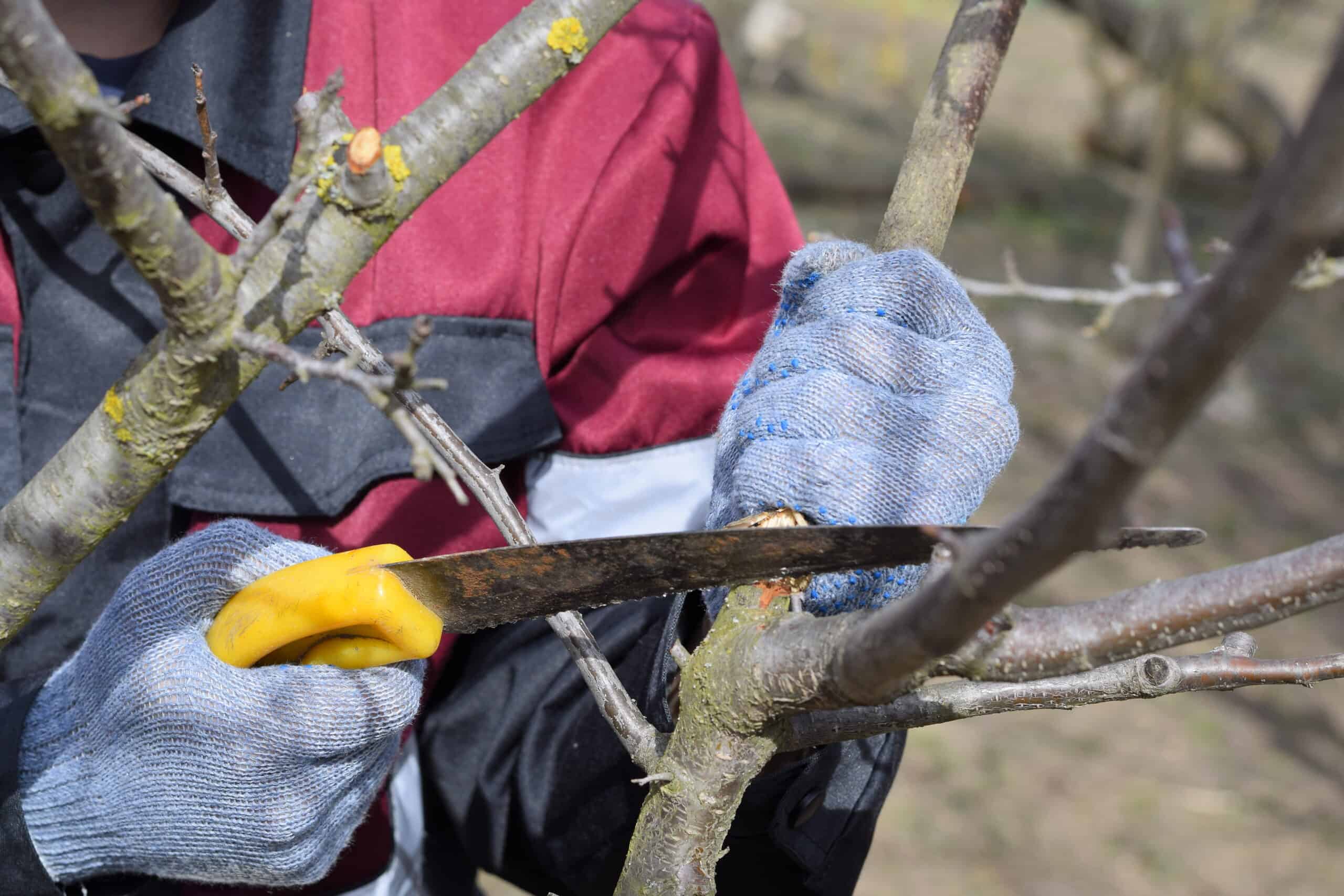
Reasons to prune fruit trees
Here are reasons to prune a fruit:
- Prune to keep the tree small and manageable. Prune a fruit tree so that fruit can be harvested without a ladder. Keep a fruit tree small enough to throw bird netting over the top. Prune so that you can reach the highest fruit by simply reaching up.
- Prune to keep branches from growing long and droopy. Prune to keep branches from touching the ground or hanging over a fence or roof. Long, droopy branches can easily break when loaded with fruit or battered by the wind. Branches that grow over fences or on rooftops are difficult to harvest.
- Prune to keep the center of the tree open; this will allow the sun to reach and ripen all of the fruit on the tree. Dense foliage in the center of the tree will result in small fruit that is less flavorful. Lack of sun can also cause foliage dieback in the center of the tree.
- Prune to remove broken, dead, and diseased branches. Prune to remove branches that rub against each other; broken and damaged branches are susceptible to disease and pest attack.
- Prune to limit the number of flowers and fruit. Too many blooms can result in too many fruits. Heavy fruit set can mean a lot of small fruit with large pits and little flesh. Trees that flower heavily and set a large amount of fruit tend to exhaust themselves; this can result in alternate bearing—that is a heavy crop one year and little or no fruit the next.
- Prune to remove suckers and water sprouts. Suckers are shoots that grow from the base of the tree or roots; water sprouts are long straight shoots that grow from limbs; they usually do not bear fruit but simply crowd the center of the tree and fruit-bearing branches.
When to prune
- Prune or pinch off soft, new growth any time during the year. Pinch away new growth to maintain the tree’s shape. Pinch or prune off water sprouts or suckers as soon as they appear. Suckers and water sprouts take energy away from fruit production; prune or pinch at any time.
- Deciduous fruit trees are commonly pruned before spring growth before the tree begins to leaf out. Pruning just before spring growth begins allows you to see the tree’s branches clearly. Midwinter (January in the northern hemisphere) is when a deciduous tree will be most dormant; that is the time to prune.
- Finish pruning deciduous fruit trees before buds start to swell in early spring. Buds swell when tree sap begins to move in the tree. If the sap is active, pruned wood will drip sap.
- Delay pruning if you are not sure which spring buds are leaf buds and which buds are fruit buds. If you delay a week or so, you can tell the difference. Leaf buds are thin; fruit buds become plump and roundish.
- Prune after harvest. Deciduous fruit trees can be pruned in summer or autumn after a harvest. Remove center shoot growth that shades larger fruit-bearing branches. Prune shoots as thick as a pencil or thicker. Prune out center growth that shades fruit-bearing wood over a two or three-week period gradually exposing the center of the tree to increase sun.
Fruit tree pruning strategy
Trees less than four years old
- Prune to create a strong branch system; prune to create a strong framework. Pruning in the first four years centers on developing a strong system of branches.
- Cut newly planted deciduous fruit trees to 9 inches above the graft or bud union. This initial pruning will leave little more than a stub in the ground. This short stump will become the foundation for a fruit tree that can be harvested by hand without the use of a ladder.
- Side branches will form just below the cut. These first framework branches eventually will be not much more than 1 foot or so above the ground.
- Side branches will be thinned to three strong shoots evenly spaced around the tree and also spaced up and down the trunk separated by four inches or more. Looking down on the tree from above these young structural branches will be evenly spaced like the spokes of an umbrella.
- Allow structural branches to grow unimpeded for the first year. In the second spring, trim these branches back to about 18 inches. These will become the tree’s framework branches. In time they will grow branches of their own, secondary branches.
- Second-year branches will become fruit-bearing. These branches will be pruned in winter each year to develop more fruiting wood.
- Third and fourth years, prune to establish and maintain the shape of the tree. Prune to keep the tree from growing too large.
- Pruning results in increased twiggy growth; twiggy growth can crowd the center of the tree. Prune away congested twiggy growth and shoots. Inner branches that do not get light will not produce viable fruit. Fruit-bearing wood at the center of the tree must get sunlight. Prune congested twiggy and shoot growth lightly in summer.
Trees older than four years
- Prune to maintain the tree’s shape and size.
- Prune back new growth by one-third each year to maintain size.
- Remove broken, dead, and diseased wood. When removing diseased wood, cut it back well into healthy wood.
- Prune away suckers growing from the base of the plant and water sprouts growing vertically from branches. Remove these when you first spot them at any time of the year.
- Prune to keep the center of the tree from becoming crowded. Cutaway shoots or branches that are crossing or rubbing.
- If a pruning cut to remove diseased wood reveals a deeper infection, cut deeper until no sign of infection is evident.
Peach and nectarine: fruit and leaf buds and pruning
- Thin buds are leaf buds.
- Fat buds are flowers or fruit buds.
- Flower and fruit buds tend to develop on branches that are a pinkish color.
- Greenish wood or shoots are last year’s growth.
- Single buds on one-year-old green wood can bear fruit. A tree should not have too many green shoots; it should bear most of the fruit on pinkish wood.
- Pinkish-colored wood is two years old. Triple buds develop on two-year-old wood; two buds are thin leafy buds; one bud is fat—a fruiting bud. Fruit develops on pinkish two-year-old wood.
- A single, narrow bud at the end of a twig will produce leaves; further back you will find triple buds. Triple buds develop two leaves and a flower in the center. Further back on the twig or wood is old wood that will not produce fruit unless it is cut back and sent out new shoots.
- Dark-colored three-year-old wood will not develop fruit.
- If a tree is covered thickly with flower buds and all are pollinated, the fruit will be small. It is best to pinch off buds so the remaining buds are evenly spaced by 6 inches or so.
- Peaches and nectarines are vigorous growers, remove half of the pink wood where there are triple buds, especially if there has been a lot of shoot growth.
- Remove branches that grow too tall or rangy.
Apples and pears: fruit and leaf buds and pruning
- Thin buds are leaf buds.
- Fat buds are flowers or fruit buds.
- Young apples and pears produce flowers and fruit on the ends of new growth.
- Cut most shoots back on young trees to keep them small and manageable. New side shoots will grow from these shoots; these side shoots will flower at the ends also.
- As shoots or twigs mature into branches, short stubby side shoots called “spurs” begin to grow. Spurs are the flower and fruiting shoots. Spurs last for four or five years. Do not prune or damage the spurs. Spurs produce fruit.
- You can encourage spur development by pruning the ends of vigorous, two-year-old, upright shoots. When the end of a shoot is cut, side growth will develop.
- Some apple varieties tend to bear fruit only at the end of shoots other varieties don’t flower at the end of the shoot and bear only on spurs. You may need to observe the tree’s flowering habit for a year or more to determine where it will flower and bear fruit.
- Pear trees grow more slender and angular than apple trees; young trees have bear terminal flowers; older trees flower more on spurs. Cut back tall growth on pears.
- When possible, prune to keep most of the spurs on the inside of the tree where the fruit will be shaded from direct sun.
Cherry and apricot: fruit and leaf buds and pruning
- Thin buds are leaf buds.
- Fat buds are flowers or fruit buds.
- Flower and fruit buds tend to develop on last year’s growth.
- Unlike peaches, cherry, and apricot wood do not turn from green to pink to dark brown or gray; there is no color change as the wood gets older it remains a dark brown.
- Short-side shoots called spurs begin to develop on second-year wood; spurs remain on twigs as they turn into branches. Spurs grow 3 inches long and live for three years.
- Spurs are fruit-bearing; do not remove fruit-bearing twigs or spurs.
- Flowers and fruit are borne on the sides of one-year-old twigs and on spurs growing on two- and three-year-old wood.
Pruning citrus trees
- Citrus is not deciduous; it is evergreen. Citrus can be pruned at any time of the year.
- Citrus trees require little pruning. Prune to maintain size and shape.
- Prune citrus by walking around the tree and pinching or clipping out terminal growth; this will keep the tree from becoming rangy. Pinch or clip back terminal growth in spring and summer.
- Cut back long branches that have no side shoots. This will stimulate side shoots.
- Citrus flowers and fruits on side shoots.
- Oranges, mandarins, and grapefruit require almost no pruning apart from topping the tree to keep it from growing too tall. Top trees in spring or winter after harvest.
- Lemons develop a lot of interior shoot growth; prune this growth back as it appears to keep the interior of the tree from becoming crowded.
Pruning tools
- Always use sharp tools.
- Disinfect your tools between cuts particularly if you are removing diseased wood.
- Hand pruners are used for small twigs and shoots not thicker than a pencil.
- Loppers are used for shoots and branches thicker than your thumb; if you have to strain to cut a branch with a lopper, use a pruning saw.
- Scissor-type pruners make a slicing cut and will not bruise the wood.
- Anvil-type pruners crush wood and bark; use anvil pruners to remove deadwood.
- Pruning saws are used for larger cuts. Use a pruning saw with a narrow blade for a close cut. The teeth of a pruning saw bite or cut on the pull stroke.
- Pruning paint is used to seal the ends of cut branches. Pruning paint will keep disease organisms from entering the tree; it will also keep the cut from drying out. Many horticulturists do not use pruning paint but allow the cut to heal naturally.
Related articles:
Planning the Home Fruit Garden
Home Fruit Garden Maintenance Calendar
Garden Planning Books at Amazon:
- Vegetable Garden Almanac & Planner
- Kitchen Garden Grower’s Guide Vegetable Encyclopedia
- Vegetable Garden Grower’s Guide
- Tomato Grower’s Answer Book

